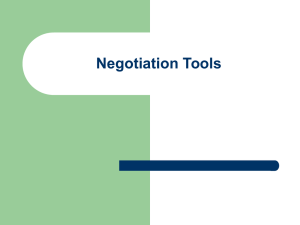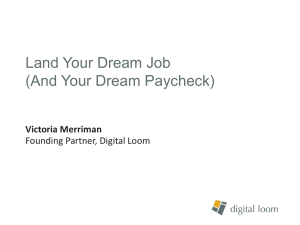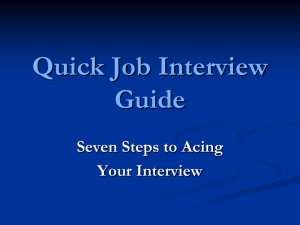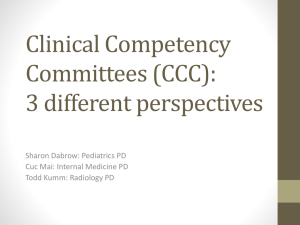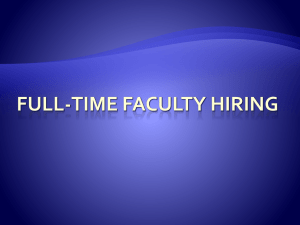Choosing And Negotiating That First Job
advertisement
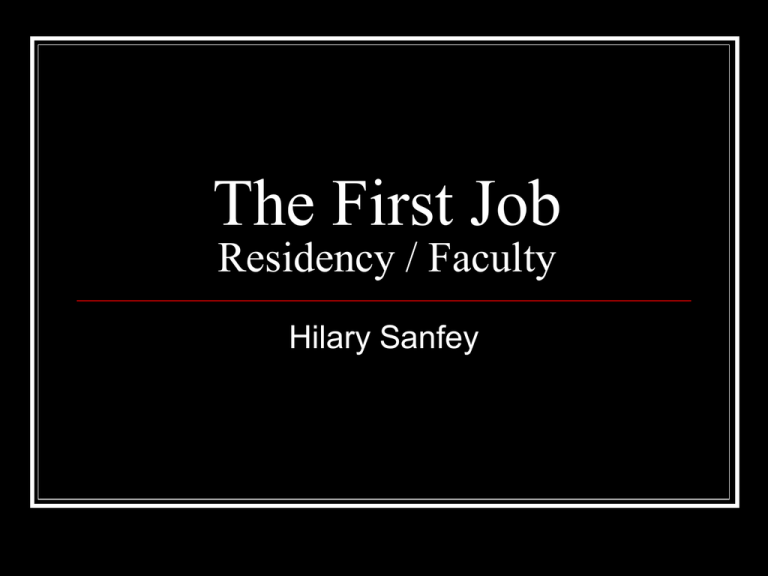
The First Job Residency / Faculty Hilary Sanfey Learning Objectives What to look for (what to avoid) Preparing yourself & your CV The interview Negotiation What to Look For & What to Avoid Be wary of institutions / programs: High faculty turnover (ask why) Financial instability Programs on probation Chair about to retire Barriers to meeting with key staff (other residents) during the interview Few minorities in key positions The Department Chair? Chair supportive of junior faculty / residents Mentorship record Promotions Opportunities for leadership National reputation Is he / she about to retire or move? Business plan Administrative support Sound billing / reimbursement system What to look for : Residency & Faculty Know your priorities & goals (1 & 5 year) Personal Professional The department / program The institution Priorities & Goals Goals should be flexible as interests & opportunities will change Personal Professional Clinical Research Promotion Leadership Financial Educational Long term (5 year) and short term (1 year) SMART Goals Specific Measurable Achievable Realistic Time Preparation Know the program / department / institution Review institutional / departmental / website / marketing brochures NIH funding Educational ranking National reputation of chair / senior faculty Talk to faculty / current and past residents / referring physicians Know yourself Application / priorities / interests Curriculum Vitae Is there an institutional template? Review CVs from successful colleagues Be concise Be honest Make sure significant achievements stand out Have an explanation for the “gaps” Watch spelling / grammar Teaching portfolio Personal Statement /Accompanying Letter Why this specialty (institution)? Personal experiences. Future expectations (vision). Spelling / grammar. Use humor cautiously. Be original. Ask advisor(s) to read prior to submission. Applying to a Residency Program Clinical Training - volume and patient mix Education – board results Research – optional vs. mandatory Environment – family friendly or hostile Hospitals – how many? How far apart? Where do residents go after training? Academic vs. private practice Fellowship placement Job Description (Residents) Duty hours / night duty / live in time Rotations Research opportunities Specialty Location / hospitals / outreach clinics Elective Funding Leave Vacation Maternity / Paternity Study Job Description (Faculty) Ascertain goals and priorities of chair / chief. Percentage time for : Clinical work. Research. Educational activities. Administration. Learn how your salary will be supported. Is there an inside candidate? Priorities & Goals Personal Professional Clinical Research Promotion Leadership Financial Educational Clinical Outreach clinics Referral pattern Who is the competition? Support for new program development Financial Staff Equipment Space Institutional commitment to a new program Research Percentage / protected time While awaiting NIH funding, ask about Salary support Start up grants Opportunity for collaboration / sharing staff , space & equipment Lab space allocation Promotion and / or Tenure Learn the rules! Tracks Educator vs. investigator Clinical vs. non-clinical Tenure vs. non-tenure Changing tracks Definition of scholarship Promotion record for each track in your department Promotion (continued) Ascertain relative importance of teaching / research / clinical / service to P & T. Time limitations / probationary periods. Are these negotiable ? Consequences of failing to obtain P&T. “time off the clock.” Leadership (Mentorship) Chair / faculty with a national reputation in your area of interest Professional organizations National / regional committees Editorial boards Can they offer you opportunities / consistent with your goals? Can you identify with the faculty? Financial How will your salary be supported? Revenue sources Salary Clinical / research / other Base Negotiated Incentives / bonus Overheads Collection rate Office / secretarial support / dean’s tax / shared administrative / clinic staff / collection fees Malpractice (tail coverage) Educational Protected time to teach Relative value placed on resident vs. medical student teaching by P&T Salary support for teaching CME requirements to maintain institutional credentials Time off to attend national meetings Personal Personal / family time / part time / flexible / maternity / paternity leave Location / commute Are benefits transferable ? College fees differential for children Schools Housing / travel expenses Hobbies / interests The Selection Process : Residency Getting an interview Academic qualifications USMLE /AOA /school CV Personal statement Letters Personal recommendation Getting a job offer / getting ranked Compatibility or “fit” Qualities Determining Compatibility Team player? Motivation? Communication skills? Leadership potential? Attitude? Compassion? Non-academic achievements? The Interview Appearance Polite Be honest / prepared / enthusiastic / well dressed / on time Write thank you letters Watch what you say at all times! Interviewing for a Faculty Position Should talk to: Chair / Chief Colleagues from your areas of interest and / or research & clinical collaboration Business manager P & T advisor Residents / Nurses / Secretarial / lab staff Person vacating the post if relevant Interviews (Faculty) The first interview The second interview OK to look once even if really not interested Demonstrating intent Accompanied by spouse / significant other The third interview Consolidate expectations Dealing with Inappropriate Questions ? The Negotiation Remember Priorities and Goals Personal Professional Clinical Research Promotion leadership Financial Educational Starting the Negotiation Wish list in order of priority Negotiable vs. not negotiable Balance your goals against what is being offered Wish List Salary AAMC guidelines plus 10% Department salary range Penalties for not covering salary Protected time Lab space Part time / flexible opportunities Negotiation The worst thing you can possibly do is seem desperate to make the deal. That makes the other guy smell blood and then you are dead.. Donald Trump Negotiation Patience may be a virtue but in negotiating it is a weapon of incalculable power. If you can out wait the other side you usually can out negotiate them. Mark McCormack Author of “On Negotiating” Take Control Speak assertively Don’t discount what you say before you say it (don’t apologize for asking!) Stay focused on your goals Don’t be seduced by promises Shake hands and come out fighting Don’t set yourself up for failure! Beware the "Once you take the job we…………… Will talk about your Salary! Office! Lab space! Promotion! OR time! Beds!” Get everything in writing Pick your battles! Compromise The Decision Compare notes with personal goals and priorities Be realistic Will I fit in? Will I be happy? Will this job help me get my next position? Goals There are two aims in life: one is to achieve your goals and the other is to take time to enjoy them. Only the wisest of mankind achieve the second aim. Logan Pearsall Smith 1965-1946 Resources American College of Surgeons http://www.facs.org/medicalstudents/index.html American Medical Association http://www.amaassn.org/ama/pub/category/2997.html Mom MD http://www.mommd.com/ AAMC http://www.aamc.org/ JAMA Career Net http://www.jamacareernet.com/ Association of Women Surgeons http://www.womensurgeons.org/ References The first 90 days : Michael Watkins On becoming a leader: Warren Bennings Hardball for women: Pat Heim Same game, different rules: Gail Evans


